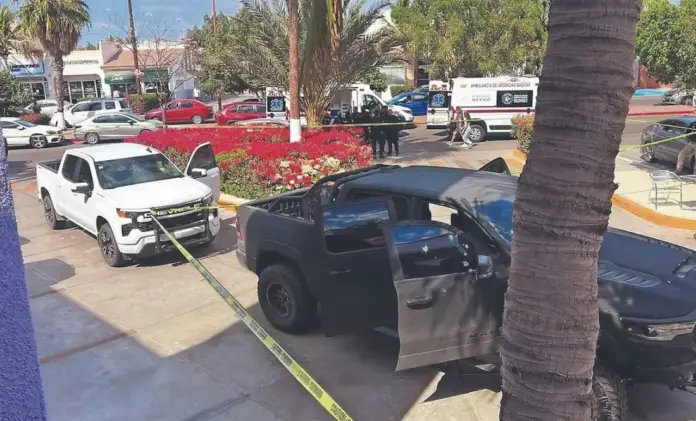A climate of tension and fear is growing in Baja California Sur, as recent days have seen frontal attacks against security officials and the appearance of narco-messages warning that the state is becoming a territory of disputes between factions of the Sinaloa Cartel.
Since 2017, when Baja California Sur closed with 610 intentional homicides, the state had not recorded any high-impact violent incidents until last week, when, at the height of the holiday season, a shooting occurred near the La Paz boardwalk, leaving two people injured, one of them allegedly an operative for one of the Sinaloa Cartel factions.
The state has experienced a week of shootings, narco-messages, bodies found with signs of torture, and threats from criminal groups to police forces.
Following the murder of Commander Ulises Omar Cota Montaño of the State Criminal Investigation Agency and a second lieutenant in Guerrero Negro, Governor Víctor Castro Cosío acknowledged that these events are the result of “revenge” for the dismantling of a criminal cell in the northern region and the resurgence of organized crime in the state. He also identified a perpetrator of violence, but declined to name the factions.
The security cabinet and police forces are investigating—following messages on narco-banners—a confrontation between the Sinaloa group led by René Bastidas Mercado, known as El 00, a former operative for Dámaso López Núñez and one of Joaquín “El Chapo” Guzmán’s closest associates, and the faction of Abraham Cervantes Escareaga, known as El Babay, who was arrested in 2017 and reportedly released and is allegedly allied with Los Zambadas.
One of the banners posted and investigated by authorities warned of a return of violence to the state and indicated that El Babay would be “fighting for the plaza.”
On Tuesday morning, another message appeared, allegedly from this criminal, in which he threatened “Commander Cota.”
In the afternoon, Commander Ulises Omar Cota Montaño, nephew of former Governor Leonel Cota Montaño and current Undersecretary of Agriculture and Rural Development, was gunned down.
Amid the tension, a video allegedly recorded by a drone circulated showing the attack on the commander. The footage has not been denied by any authority.
In this regard, the governor acknowledged that the criminals “made good on their threat,” lamented the crime, and said that “there will be no impunity.” As of yesterday, no arrests had been made in this incident.
Growing Concern
Given this scenario, analysts specializing in security and crime victim assistance warn of the possibility of a new wave of violence like the one recorded previously.
“We sense fear among citizens. It creates memories of what we experienced nine years ago, when the state ranked first in the nation in violent deaths. With that life experience, we have the impression that we are going to or could return to that status, and we are deeply concerned about the silence of the authorities and the lack of capacity to address it.
A government that has been unable to work on crime prevention is incapable of combating crime itself.”
He stated that after 2017, the crime phenomenon changed in the state, as high-impact violence in public places slowed down, but not crime.
“Instead of public displays of force, people were disappeared. The only thing that was done was to hide the visibility of the violent acts, and now they are returning. Why? It indicates that the actors who were fighting within criminal groups have lost control. The problem is that we don’t have an immediate and effective response from the state,” the expert emphasized.
Years of Violence
In 2006, according to the Executive Secretariat of the National Public Security System, Baja California Sur recorded a total of 20 intentional homicides.
The then governor, Narciso Agúndez Montaño, boasted that Baja California Sur was the safest state in the country in a violent national context; however, in 2014 the situation changed after the recapture of El Chapo.
In July 2014, clashes between factions of the Sinaloa Cartel began. Federal authorities acknowledged that the Jalisco New Generation Cartel was also fighting for territory. That year, violence resulted in 70 intentional homicides and continued to rise: 151 in 2015; 216 in 2016; and 610 in 2017.
Following a travel advisory issued by the United States government for the state’s tourist destinations, among the most important in the country, the federal government announced a joint strategy: More than 1,000 military personnel arrived and two military barracks were established, one with investment from businessmen in Los Cabos.
In addition, military commanders were appointed to the local police force, and a new prosecutor, Daniel De la Rosa Anaya, who held the position for seven years and resigned last week for personal reasons, was appointed.
In his farewell address to the governor, he thanked him for the results in the decrease in homicides. 2024 closed with 56 cases.
However, recent violent events coincide with his departure, although no authority has addressed the issue.
Castro Cosío admitted that the violence in the state generates “uncertainty” and assured that surveillance will be strengthened with a coordinated strategy with the federal government.
Melchor Soto Torres, a member of the citizen council on missing persons in the state, told EL UNIVERSAL that the wave of violence recorded from 2014 to 2017 left “many collateral victims” who were never assisted because there is no victim assistance policy in the state, “only on paper.”
He noted that the effects a crisis of violence could have on citizens are worrying.

Source: eluniversal




